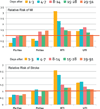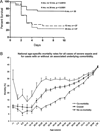Translational research in immune senescence: assessing the relevance of current models
- PMID: 22633440
- PMCID: PMC4018581
- DOI: 10.1016/j.smim.2012.04.007
Translational research in immune senescence: assessing the relevance of current models
Abstract
Advancing age is accompanied by profound changes in immune function; some are induced by the loss of critical niches that support development of naïve cells (e.g. thymic involution), others by the intrinsic physiology of long-lived cells attempting to maintain homeostasis, still others by extrinsic effects such as oxidative stress or long-term exposure to antigen due to persistent viral infections. Once compensatory mechanisms can no longer maintain a youthful phenotype the end result is the immune senescent milieu - one characterized by chronic, low grade, systemic inflammation and impaired responses to immune challenge, particularly when encountering new antigens. This state is associated with progression of chronic illnesses like atherosclerosis and dementia, and an increased risk of acute illness, disability and death in older adults. The complex interaction between immune senescence and chronic illness provides an ideal landscape for translational research with the potential to greatly affect human health. However, current animal models and even human investigative strategies for immune senescence have marked limitations, and the reductionist paradigm itself may be poorly suited to meet these challenges. A new paradigm, one that embraces complexity as a core feature of research in older adults is required to address the critical health issues facing the burgeoning senior population, the group that consumes the majority of healthcare resources. In this review, we outline the major advantages and limitations of current models and offer suggestions for how to move forward.
Copyright © 2012 Elsevier Ltd. All rights reserved.
Figures





Similar articles
-
The immune system in extreme longevity.Exp Gerontol. 2008 Feb;43(2):61-5. doi: 10.1016/j.exger.2007.06.008. Epub 2007 Jul 4. Exp Gerontol. 2008. PMID: 17870272 Review.
-
The future of Cochrane Neonatal.Early Hum Dev. 2020 Nov;150:105191. doi: 10.1016/j.earlhumdev.2020.105191. Epub 2020 Sep 12. Early Hum Dev. 2020. PMID: 33036834
-
Telomere Dynamics in Immune Senescence and Exhaustion Triggered by Chronic Viral Infection.Viruses. 2017 Oct 5;9(10):289. doi: 10.3390/v9100289. Viruses. 2017. PMID: 28981470 Free PMC article. Review.
-
Persistent viral infections and immune aging.Ageing Res Rev. 2011 Jul;10(3):362-9. doi: 10.1016/j.arr.2010.08.003. Epub 2010 Aug 19. Ageing Res Rev. 2011. PMID: 20727987 Review.
-
[Senescence of the immune system and alterations related with asthma].Rev Alerg Mex. 2017 Apr-Jun;64(2):206-219. doi: 10.29262/ram.v64i2.264. Rev Alerg Mex. 2017. PMID: 28658729 Review. Spanish.
Cited by
-
Immunosenescence and Aging: Neuroinflammation Is a Prominent Feature of Alzheimer's Disease and Is a Likely Contributor to Neurodegenerative Disease Pathogenesis.J Pers Med. 2022 Nov 2;12(11):1817. doi: 10.3390/jpm12111817. J Pers Med. 2022. PMID: 36579548 Free PMC article. Review.
-
Chronic immune activation and accelerated immune aging among HIV-infected adults receiving suppressive antiretroviral therapy for at least 12 years in an African cohort.Heliyon. 2024 May 24;10(11):e31910. doi: 10.1016/j.heliyon.2024.e31910. eCollection 2024 Jun 15. Heliyon. 2024. PMID: 38882354 Free PMC article.
-
Enhancing vaccine effectiveness in the elderly to counter antibiotic resistance: The potential of adjuvants via pattern recognition receptors.Hum Vaccin Immunother. 2024 Dec 31;20(1):2317439. doi: 10.1080/21645515.2024.2317439. Epub 2024 Mar 4. Hum Vaccin Immunother. 2024. PMID: 39693178 Free PMC article. Review.
-
Immune correlates of aging in outdoor-housed captive rhesus macaques (Macaca mulatta).Immun Ageing. 2012 Nov 14;9(1):25. doi: 10.1186/1742-4933-9-25. Immun Ageing. 2012. PMID: 23151307 Free PMC article.
-
Is HIV a model of accelerated or accentuated aging?J Gerontol A Biol Sci Med Sci. 2014 Jul;69(7):833-42. doi: 10.1093/gerona/glt168. Epub 2013 Oct 24. J Gerontol A Biol Sci Med Sci. 2014. PMID: 24158766 Free PMC article. Review.
References
-
- Smeeth L, Thomas SL, Hall AJ, Hubbard R, Farrington P, Vallance P. Risk of myocardial infarction and stroke after acute infection or vaccination. New England Journal of Medicine. 2004;351:2611–2618. - PubMed
-
- Akbar AN, Henson SM. Are senescence and exhaustion intertwined or unrelated processes that compromise immunity. Nature Reviews Immunology. 2011;11:289–295. - PubMed
Publication types
MeSH terms
Grants and funding
LinkOut - more resources
Full Text Sources
Medical

